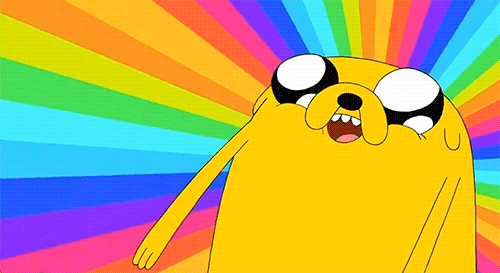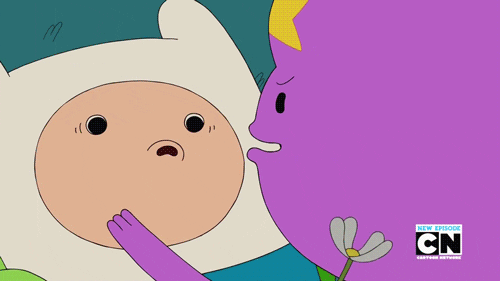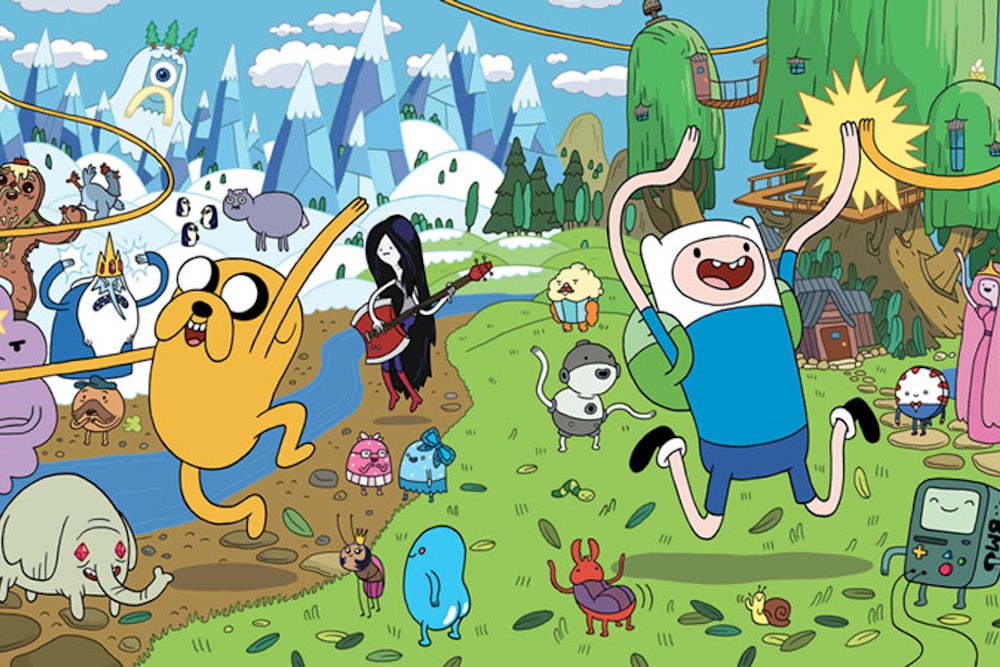When Adventure Time premiered in 2010, I was sixteen, and the first episode was widely sent around my high school with some variation on the line: Can you believe this kid’s show? It’s so *trippy*. It was that association with psychedelia that very likely got the show from children to stoners, and from stoners to the broader audience of teens and young adults it now enjoys. Google the show, and you’ll find no shortage of professional TV criticism focusing on Adventure Time’s technicolor aesthetic, which, to be fair, does make liberal use of rainbows. But the “trippy” label is one of the great short sells of the show, rendering it as flat as its pastel landscapes. As creator Pendleton Ward has said of his fictive universe, “It’s candyland on the surface and dark underneath, and that’s why it’s compelling, I think.”
Adventure Time has always been a thing of many pleasurable contradictions: it is silly but profound; it is free-associative in form but intricately plotted; it’s mature, but kind of innocent. While it shares DNA with beloved adult cartoons like Futurama and BoJack Horseman, it is not fully inside that tradition. In Cartoon Network’s lineup, it sits precariously in the 7:45 pm slot—the lone, 15-minute buffer between We Bare Bears and Adult Swim reruns of King of the Hill. It has been a beautifully managed balancing act, but, as the show begins its seventh year and penultimate season, the scales are beginning to tip. And for the better.
The show has cemented its core audience through longer-term constructs—the deepening development of its characters and the incremental revelations about the transformation of our Earth into Adventure Time’s Land of Ooo, by means of a long-ago nuclear war that wiped out civilization but unleashed magic back into the world. As the show nears its end, and as its protagonist, Finn, comes of age, it seems committed to bringing its plot promises to fruition, at the expense of some of its freeform, child-like silliness. Islands, the 8-part miniseries running today until February 2, takes a big step in addressing one of the show’s central mysteries—what happened to the human population in the aftermath of the nuclear Mushroom War, and if any other humans besides Finn (and maybe-cyborg Susan) remain alive.
Islands does a dizzying amount of plot development in 80-something minutes. The action starts with a mysterious aircraft landing on the beach in search of Finn. Finn, Jake the dog, Susan, and stowaway BMO then leave Ooo, hoping to discover the aircraft’s place of origin and encountering a series of the eponymous islands. Each island offers a different variation of a dystopian human future. There is the gentle, lone survivor living in a hollow tree. There is an island of humans hooked up to pods, living through a “Better Reality” virtual reality game, as tiny sweet-faced drones tenderly care for their atrophying bodies. There is a city tightly guarded by an animatronic giant that keeps any wayward citizens from venturing out into a presumably decimated and dangerous world, and ominously “reeducates” them when they’re caught trying.

It is here that we finally get to the bottom of Finn’s origins: the society from which he came, how he ended up a lost infant to be found and raised alongside Jake the dog, and what remains of his family. All of this involves quite a bit of world-building and some closure for Finn, while reaffirming his place back in Ooo, where he is at home and needed to help its citizens. And while Islands is plot-focused, it certainly doesn’t sacrifice Adventure Time’s off-beat humor, even if this humor is becoming, gently, more adult. In the the first episode of Islands there’s a brilliantly bizarre bra-fitting joke: “I know they’re professionals, but it’s just too intimate” says BMO, a sentient but ambiguously gendered Gameboy-like robot. It’s a moment I had to go back and watch again, but must have been way over the heads of the prepubescent boys the show used to target.
If you believe that Adventure Time is anything like a trip on hallucinogens, it’s clear you have never actually used them. Its imagery isn’t particularly psychedelic; in fact, its influences range from The Marvelous Misadventures of Flapjack (on which Pendleton Ward was a writer and storyboard artist) to the films of the legendary anime director Hayao Miyazaki. The show even has enough formal flexibility to invite guest animators for occasional experiments in different styles. Often, the word “surreal” is used interchangeably with “trippy” when discussing the show’s central qualities—its absurdity, its fantastical elements, its apparent randomness. Adventure Time is certainly surreal, but it adheres to a deeper, more earnest kind of surrealism that is distinct from some inchoate sense of oddity.
Surrealism was, after all, an artistic reaction to despair and to the perceived failures of the prevailing rational system of thought that led to World War I. Unlike Dada, surrealist art comes not from nonsense, but from the equal union of our conscious and unconscious selves. Adventure Time feels that way, surrealism with heart, addressing our angsts and hopes and what it means to be alive. It centers conscious human conditions—confusion over one’s identity, desire for connection—and suffuses them with the color of dreams.
It also has a politics. Part of Adventure Time’s millennial appeal is no mystery—the team of writers, animators, and producers driving the show skews very young. Ward was only 27 when Adventure Time premiered in 2010. The show has consistently cultivated young creatives like storyboard artist Rebecca Sugar, who went on to become Cartoon Network’s first female show-creator at 26 with Steven Universe, another favorite among Adventure Time’s young adult demographic. It might be this influence that imbues Steven Universe and Adventure Time with a progressive ethos that few shows—children- or adult-oriented, animated or live-action—have matched.
Both play with gender and orientation. Adventure Time has ambiguously gendered characters like BMO, who regularly switches gender pronouns. There are male characters like Jake who occasionally wear makeup to feel pretty. The show has aired a handful of “Fionna and Cake” episodes in which all the characters are gender-swapped. It has also developed a deeply nuanced, dynamic group of female characters—Princess Bubblegum, the ever-sophisticated creator of the Candy Kingdom and scientific mastermind; Marceline the Vampire Queen, a punk rock half-demon and resident badass; and Susan Strong, a super-buff but gentle cyborg.

These are multifaceted, flawed, yet decidedly awesome girls whose growth we have gotten to watch over the course of eight seasons, whose relationships with each other are valued and explored. Marceline and PB have a centuries-long friendship, which the show has insinuated might have been romantic at some point in the past. Islands is no exception on this account—one of its chief plotlines is Susan’s reconciliation with a close female friend, with whom she eventually rides off into the unknown, parting with Finn and Jake.
Adventure Time’s thoughtfulness is not restricted to gender. It treats subjects like loss, romance, and aging with great tact and feeling. Its world-building is fastidiously coherent, for all its strangeness—the logic might be different in Ooo, but there is a logic and the show follows it. There are natural laws (you know, the four elements—fire, ice, candy, and slime). There is a mythology with origin stories and an explorable cosmos. The show also has an emotional integrity founded on compassion and insight. It is free of cynicism, but almost never devolves to cheap sentimentalism or shmaltz.
Most of its villains turn out not to be villains at all, but damaged individuals acting out of fear or pain. The series’ first antagonist, the Ice King, is revealed to have once been a human scientist, turned mad by the magic crown he used to protect a young Marceline in the ruins of human civilization. It was a moving character arc revealed over many seasons, woven deftly into the series mythology, turning one of the show’s most outlandish characters into a complex, tragic figure. This is a show that invests in its world, so its audience invests in it, too.
That’s no less true in Islands. Finn’s coming-of-age story and the exploration of the post-apocalyptic plotline are handled just as deftly as any other subject—with fun and a tinge of sorrow. We still don’t know what caused the war or who fought who. We only see the results—humans surviving in their variously flawed ways and a world made magic.
